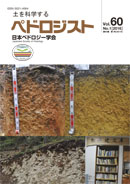Volume 60, Issue 1
Displaying 1-14 of 14 articles from this issue
- |<
- <
- 1
- >
- >|
Foreword
-
2016Volume 60Issue 1 Pages 1-3
Published: 2016
Released on J-STAGE: February 23, 2017
Download PDF (219K)
Originals
-
2016Volume 60Issue 1 Pages 4-13
Published: 2016
Released on J-STAGE: February 23, 2017
Download PDF (806K) -
2016Volume 60Issue 1 Pages 14-31
Published: 2016
Released on J-STAGE: February 23, 2017
Download PDF (2248K)
Profile
-
2016Volume 60Issue 1 Pages 32-36
Published: 2016
Released on J-STAGE: February 23, 2017
Download PDF (606K) -
2016Volume 60Issue 1 Pages 37-40
Published: 2016
Released on J-STAGE: February 23, 2017
Download PDF (609K) -
2016Volume 60Issue 1 Pages 41-43
Published: 2016
Released on J-STAGE: February 23, 2017
Download PDF (378K) -
2016Volume 60Issue 1 Pages 44-45
Published: 2016
Released on J-STAGE: February 23, 2017
Download PDF (198K)
Symposium
-
2016Volume 60Issue 1 Pages 46
Published: 2016
Released on J-STAGE: February 23, 2017
Download PDF (143K) -
2016Volume 60Issue 1 Pages 47-54
Published: 2016
Released on J-STAGE: February 23, 2017
Download PDF (1236K) -
2016Volume 60Issue 1 Pages 55-64
Published: 2016
Released on J-STAGE: February 23, 2017
Download PDF (736K) -
2016Volume 60Issue 1 Pages 65-70
Published: 2016
Released on J-STAGE: February 23, 2017
Download PDF (417K) -
2016Volume 60Issue 1 Pages 71-75
Published: 2016
Released on J-STAGE: February 23, 2017
Download PDF (523K)
Book Review
-
2016Volume 60Issue 1 Pages 76-77
Published: 2016
Released on J-STAGE: February 23, 2017
Download PDF (189K) -
2016Volume 60Issue 1 Pages 78
Published: 2016
Released on J-STAGE: February 23, 2017
Download PDF (151K)
- |<
- <
- 1
- >
- >|
